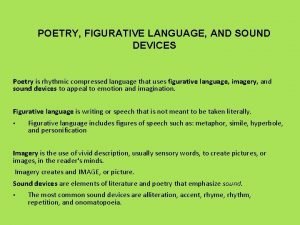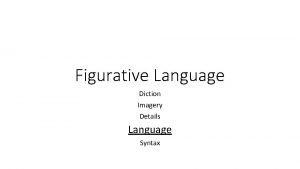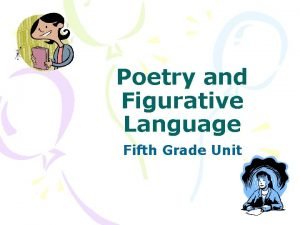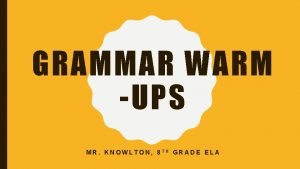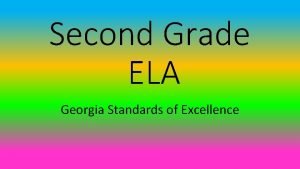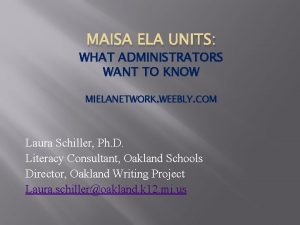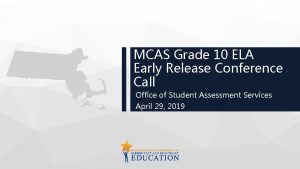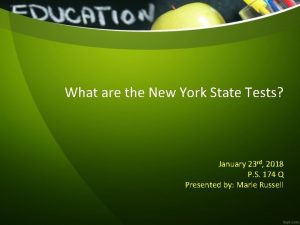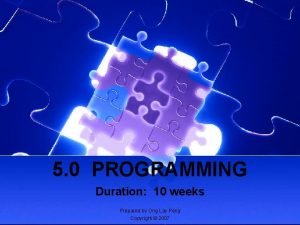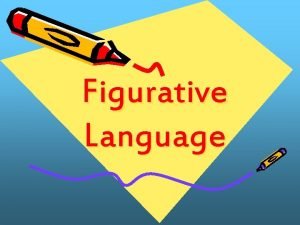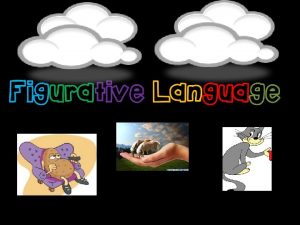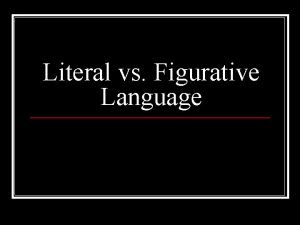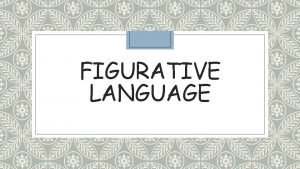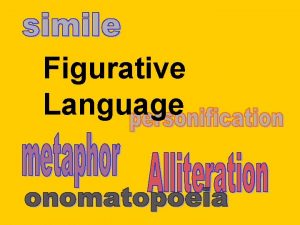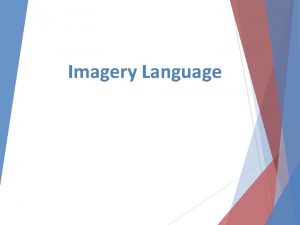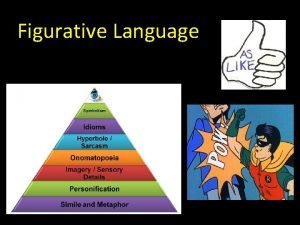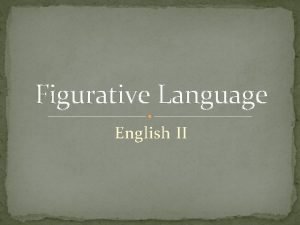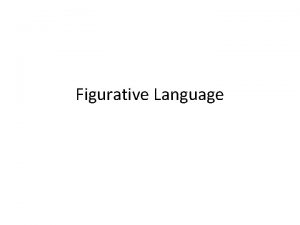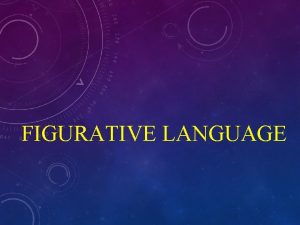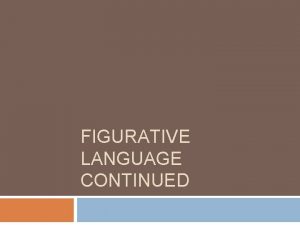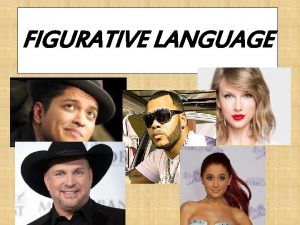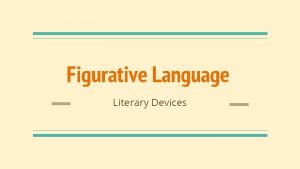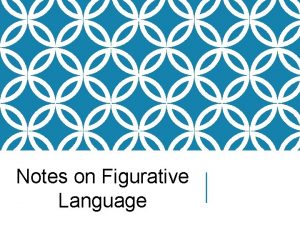THEMATIC UNIT FIGURATIVE LANGUAGE IMAGERY FOURTH GRADE ELA















- Slides: 15

THEMATIC UNIT: FIGURATIVE LANGUAGE & IMAGERY FOURTH GRADE ELA AND SOCIAL STUDIES Lisa M. Barbi

Unit Introduction: Live Life: Viva La Vida This is an interdisciplinary unit designed for fourth grade students. This unit lesson incorporates interpretation of figurative language in music and lyrical writing. The students will assess the aesthetic aspects of the artwork on the album (CD) cover and in the music video and discuss their perceptions in writing and orally of each. The students will connect how the music and artwork are connected to art history, and perform an analysis of civics and human nature through observation of related paintings/artwork, music videos, and creative writing. Lisa M. Barbi

OBJECTIVES & GOALS q q q Students will obtain an appreciation of lyrical poetry as a literary form and Expressive art by analyzing its characteristics. Students will be able to express feelings elicited by the song, “Viva La Vida” and related artwork and music video. ESSENTIAL QUESTIONS q q Students will assess the lyrics of the song, “Viva La Vida” by Coldplay and justify personal interpretations of the lyrics, music video, and album artwork through dramatic role play. Students will debate personal interpretations of the song using evidence gathered from web-based research. q Students will use figurative language to express ideas and create imagery through creative writing. q q q Students will compose original lyrics using figures of speech and imagery through use of similes, metaphors, alliteration, and personification. Students will create original artwork depicting the mood and theme of his or her original lyric composition. Lisa M. Barbi q How does “Viva La Vida” use historical events to express personal experience? How does the artist use texture and color to show mood and time period of the song? How do the musicians use music to convey mood? How can the song lyrics be relevant to the singer and to you personally? How can you use music and art to convey a message?

ACADEMIC STANDARDS: ELA Standards: q q q E 04. B-K. 1. 1. 3: Explain events, procedures, ideas, steps, or concepts in a historical, scientific, or technical text, including what happened and why, based on specific information in the text. E 04. B-V. 4. 1. 2: Demonstrate understanding of figurative language, word relationships, and nuances in word meanings. a. Explain the meaning of similes and metaphors in context. b. Recognize and explain the meaning of common idioms, adages, and proverbs. c. Demonstrate understanding of words by relating them to their antonyms and synonyms. q E 04. D. 2. 1. 1: Choose words and phrases to convey ideas precisely. q E 04. E. 1. 1. 2: Develop the analysis using a variety of evidence from text(s) to support claims, opinions, ideas, and inferences. Lisa M. Barbi Civics and Government Standards: q 5. 2. 3. A: Identify personal rights and responsibilities. q CC. 1. 4. 4. W: Recall relevant information from experiences or gather relevant information from print and digital sources; take notes and categorize information, and provide a list of sources. q 5. 2. 4. C: Describe the roles of leadership and public service in school, community, state, and nation. q 5. 2. 4. D: Describe how citizens participate in school and community activities. q 5. 3. 3. F: Explain how an action may be just or unjust. q 5. 3. 3. G: Identify individual interests and explain ways to influence others.

ACADEMIC STANDARDS: Arts and Humanities Standards: q 9. 1. 3. A: Know and use the elements and principles of each art form to create works in the arts and humanities. q 9. 1. 3. B: Recognize, know, use and demonstrate a variety of appropriate arts elements and principles to produce, review and revise original works in the arts. Dance: • move • perform • read and notate dance • create and choreograph • improvise. Music: • sing • play an instrument • read and notate music • compose and arrange • improvise Visual Arts: • paint • draw • craft • sculpt • print design for environment, communication, multi-media q 9. 1. 3. E: Demonstrate the ability to define objects, express emotions, illustrate an action or relate an experience through creation of works in the arts. q 9. 2. 3. A: Explain the historical, cultural and social context of an individual work in the arts. q 9. 2. 3. B: Relate works in the arts chronologically to historical events q 9. 2. 3. C: Relate works in the arts to varying styles and genre and to the periods in which they were created. Lisa M. Barbi q 9. 2. 3. D: Analyze a work of art from its historical and cultural perspective. q 9. 2. 3. F: Know and apply appropriate vocabulary used between social studies and the arts and humanities. q 9. 2. 3. G: Relate works in the arts to geographic regions: Europe North America q 9. 2. 3. I: Identify, explain and analyze philosophical beliefs as they relate to works in the arts (e. g. , classical architecture, rock music, Native American dance, contemporary American musical theatre). q 9. 2. 5. A: Explain the historical, cultural and social context of an individual work in the arts. q 9. 3. 3. A: Recognize critical processes used in the examination of works in the arts and humanities. Compare and contrast. Analyze Interpret.

LEARNING EXPERIENCE: q Students will listen to the song, “Viva La Vida” by Coldplay as a class and they will be directed to write down anything that comes to mind while listening to the song and watching the video. q Students will write down and then discuss the feelings they experienced while listening to “Viva La Vida” and watching the video. q Students will be directed to note the texture of the images in the video and on the album artwork (displayed by the teacher) while the teacher describes artwork of the French Revolutionary period while comparing it to that of the American Revolutionary period, which is being discussed in Social Studies. q Students will work as a class and in small groups to discuss his or her feelings about the period, artwork, mood, and tone set by the music and artwork. This discussion will be teacher guided and student driven. q Students will note, with guidance and modeling from the teacher, religious references, historical references, as well as personal experiences that relate to the song and music video for “Viva La Vida”. q Students will discuss essential questions and document draft responses to each. q Students will perform online research to gather facts about the meaning of “Viva La Vida” as well as research about historical figures mentioned in the lyrics of the song. q Students will then choose their favorite song and create original lyrics to replace the current lyrics of the song using the same meter and rhythm. q Students will create artwork by hand (mosaic, collage, drawings, tactile graphics) or via computer graphics illustrate the original lyric they created. q Students will pick a favorite part of the song and role play that part within small groups. Lisa M. Barbi

MUSIC ACTIVITY: Before: The teacher will ask the class if they ever noticed how the words to music sound like a poem and vice versa. The teacher will then ask the students how they feel when they listen to their favorite song. The teacher will prompt the students to listen quietly to the song played while writing down words or making drawings of the emotions felt while listening to the song. The teacher will ask the students to note the instruments used to convey the mood of the song. During: The teacher will circulate the room while “Viva La Vida” is playing to observe student reactions and ensure students are cooperatively and actively listening. The song will be played twice to allow students to fully experience the lyrics and music. The students may choose to sing along. After: The teacher will direct students to break into small groups to think-pair-share what they have written in response to listening to the song. After two-five minutes, the teacher will reconvene the class and ask for student volunteers to share thoughts and feelings elicited from the listening process. Lisa M. Barbi

VISUAL ARTS ACTIVITY: Before: The teacher will ask the class if they ever noticed how the images in a music video are chosen to express the mood and them of a song. The teacher will then ask the students To watch the music video for “Viva La Vida” and note the colors, images, texture, and camera angle of the video. The teacher will prompt the students to watch quietly and write down words or make drawings of the emotions felt while listening to the song. During: The teacher will circulate the room while “Viva La Vida” is playing to observe student reactions and ensure students are cooperatively and actively watching the video. After: The teacher will direct students to break into small groups to recreate an image through a mosaic, collage, or drawing based on the video scene that most influenced their feelings. The students will use tactile objects (stickers, glitter, pipe cleaners, fabric), paint, crayons, markers, chalk, construction paper and other art supplies to create texture and color to express their perceptions of the images captured in the “Viva La Vida” music video. Lisa M. Barbi

CREATIVE WRITING ACTIVITY: Before: The teacher will ask the class to answer of the following questions: “How did the lyrics of the song, “Viva La Vida”, discuss history? ”, “How did the song use words to create imagery? ”. “How do the lyrics of your favorite song make you feel? ”. After discussing student responses, the teacher will provide students with definitions of metaphors, similes, alliteration, and personification. During: The teacher will have students research the lyrics of their favorite songs on the Internet and print them out. Next, the teacher will prompt the students to change the lyrics to their favorite song to create a new and original song. The students will use the writing process to complete this assignment and type up the new lyrics using word processing software. After: The teacher will ask each student to present his or her original lyrics poem to the class. The students may choose to read the poem, sing the poem, or act out the poem. Lisa M. Barbi

DRAMA ACTIVITY: During: The teacher will instruct the students to break into small groups and pick a favorite scene from the “Viva La Vida” music video to act out or role play. The students will use movement, gestures, and props to convey the message of the scene. Lastly, each group will explain why they choose that scene. Before: The teacher will ask the class if how Coldplay combined music, lyrics, art, and physical acting to convey the message of the song “Viva La Vida”. Next, the teacher will model how gestures, movement, and props can help to convey the messages. The class will watch the “Viva La Vida” video on Youtube. com, http: //www. youtube. com/watch? v=dvg. Zkm 1 x. WPE to assess movement, gestures, and props used to convey the mood and theme of the song. After: The students will reconvene as a whole class to discuss how movement, gestures, and props can be combined with music and words to create imagery and convey mood, theme, and tone. Lisa M. Barbi

MOTIVATION: The teacher will introduce the unit by asking questions such as, “How does your favorite song make you feel? ” and “How do we use words to create pictures in our minds? ”. Through the use of a modern, pop song as a resource, the students will be motived to move and sing because they are familiar with the lyrics and music. Next, the students will learn to critique artwork and music through firsthand experience. The students will also find that lyrics to songs can convey historical information and personal feelings. The students will learn how to demonstrate their perceptions through creating original artwork based on scenes from the music video and song, “Viva La Vida”. The students will learn about the types of figurative language used in writing lyrics and create his or her own lyric poem using a favorite song. Lastly, the students will learn how gestures, movement, and props convey messages and feelings in dramatic, role play. INSTRUCTIONAL STRATEGIES: The teacher will employ various instructional strategies to implement this unit plan. Some of these strategies will be: Small group work and instruction Peer mentors Differentiated instruction Think-pair-share Use of kinesthetic, musical, research, tactile, and writing activities to address various multiple intelligences Safe and inviting environment with clustered desks, informative posters including the writing process and types of figurative language Lisa M. Barbi

MATERIALS AND RESOURCES: q q q q q Smartboard “Viva La Vida” CD with Album Cover Youtube. com official music video of “Viva La Vida”, http: //www. youtube. com/watch? v=dvg. Zkm 1 x. WPE “Viva La Vida” lyrics from A to Z Lyrics, http: //www. azlyrics. com/lyrics/coldplay/vivalavida. html, Ipads, tablets, and/or PCs Internet access Lined paper Writing utensils Art supplies including fabric, stickers, glitter, crayons, paint, paper etc. Lisa M. Barbi

ASSESSMENT PART 1: INTERPRETATION Student interpretations and discussions will be assessed using the following rubric: Lisa M. Barbi

ASSESSMENT PART 2: LYRIC & ILLUSTRATION Student lyrics and illustrations will be graded using the following rubric: Lisa M. Barbi

SELF REFLECTION: This thematic unit is a very dear lesson to me because I have used a variation of it in previous teaching experiences. The song lyrics are a great source for self-reflection while the music is positive and uplifting. I find that multimedia resources and expressive arts activities make the lesson relevant to students. Through the students’ interpretations of the “Viva La Vida” lyrics, original artwork and lyrics, as well as dramatic role play, I can determine how well I motivated my students to think outside the box and see how “real life” influences “academic life”. Lisa M. Barbi
 Imagery and sound devices chart
Imagery and sound devices chart Imagery figurative language
Imagery figurative language Is imagery a figurative language
Is imagery a figurative language Is diction a figurative language
Is diction a figurative language Thematic statement examples for loyalty
Thematic statement examples for loyalty Welcome to fourth grade
Welcome to fourth grade Couplet figurative language
Couplet figurative language 8th grade ela warm ups
8th grade ela warm ups 2nd grade ela standards georgia
2nd grade ela standards georgia Maisa ela 8th grade
Maisa ela 8th grade Mcas ela grade 10
Mcas ela grade 10 Engageny ela grade 5 released questions
Engageny ela grade 5 released questions Example of fourth generation programming language
Example of fourth generation programming language Venn diagram of literal and figurative language
Venn diagram of literal and figurative language What is figurative
What is figurative Literal vs figurative examples
Literal vs figurative examples
